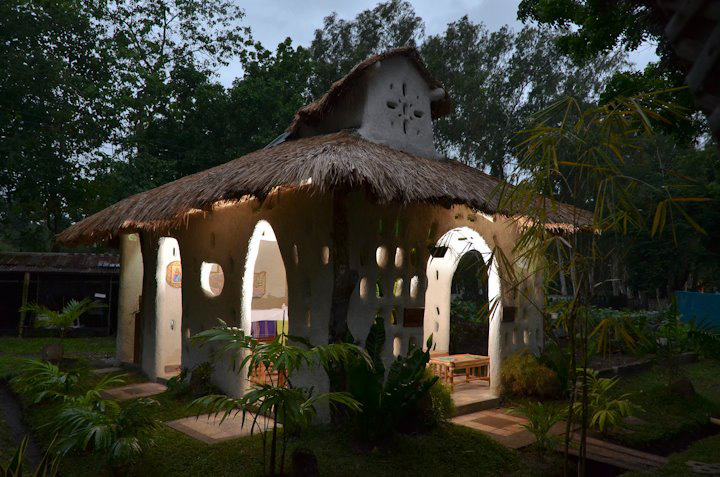Three Negrense artists unite in building the “earth chapel,” a collaborative work anchored on their common advocacy of protecting the environment. The chapel is located within the area of the Greenheart Hermitage (at the campus grounds of the University of Negros Occidental – Recoletos) in Bacolod City, Negros Occidental, Philippines.
Greenheart Hermitage gathers three artists to build a chapel, made of indigenous materials (the structure is made of mud, bamboo, rice straw and stalk and cogon grass) and recycled materials (wine bottles, discarded tiles, discarded wood slab, etc.). The three offered their work, time and talent pro bono, to realize the chapel; Marisol Alquizar, designed the chapel, she is a visual-artist who dedicates her time building mud houses in the island of Negros; Brother Tagoy Jakosalem, a Rekoleto friar and an official presenter of The Climate Reality Project, did the interior and conceptualize the incorporation of renewable energy into the structure – making the chapel true to form and function in its liturgical scheme; and Nunelucio Alvarado, a leading social-realist artist in the country; designed the crucifix for the chapel, from his pen and ink version of “Kristo ni Alvarado” transformed into a colorful mosaic as the centerpiece of the chapel – Christ as a suffering sacada, offering his suffering for the sake of all. For Alvarado “The Christ that I made is a sugar worker, he is like a sacada who is nailed by oppression and abuse… in the same way, the Christ that we nailed on the cross because of our sinfulness.” Ms. Alquizar pointed out “the bayanihan spirit is an essential output and process in creating the mud chapel… students and staff building a community as the build the mud house.” “We build the mud chapel from the income of our recycling facility, out of the sales of the plastic bottles that we recycle…” Brother Jakosalem said.
The chapel is the first solar-powered religious edifice in the country, it is envisioned both to have a sound spiritual and environmental atmosphere, LED lights are used to illumine the interior. Wine bottles are incorporated in the structure, natural lighting effects emanating from the green-colored wine bottles, serving as recyclable stained-glass windows.
Working on a mud chapel, is a labor intensive exercise; that truly needs a collective manpower. The chapel, started its skeleton from the hands of volunteer students, who are all active members of the Tsinelas of Hope; offering their time to give life to the chapel.
We are envisioning the chapel to be the center of our ecological reflection, owing to the spiritual inspiration of our Creator; hoping to be transformed to be men and women of faith committed to protect and preserve the earth.
The earth chapel will again add another spiritual and liturgical venue in the island of Negros, aside from the “Chapel of the Angry Christ” in Victorias and of the “Chapel of the Cartwheels” in Manapla. We now have a chapel that will become a model of how a place of worship can maximize the use of renewable energy and of using indigenous materials as its structure.


